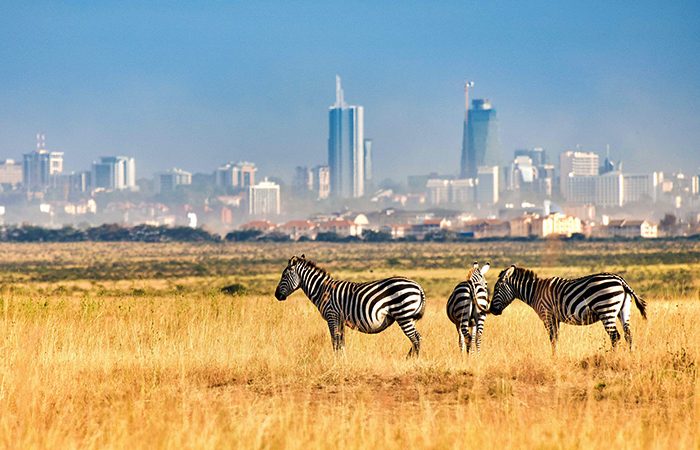
History of Nairobi National Park
History of Nairobi National Park, is a national park in the south-central Kenya, 5 miles (8km) south of Nairobi. It was the first national park to be established in Kenya ( 1946), has an area of 45 square miles ( 117 square km), and lies about 5,000 to 6,000 feet (1500 to 1800 meters) above the sea level. It consists partly of thick woods near the city outskirts, partly of rolling plains and valleys, and partly of a wooded confluence of the several rivers. Its vegetation is of the dry transitional savanna type. Acacias and other thorny varieties, muhuhu, Cape chestnut, and Kenya olive are the most important trees. Scores of mammals, such as the lions, gazelles, black rhinoceroses, giraffes, various species of antelope, and zebras as well as numerous reptiles and hundreds of species of the birds, inhabit the park. Only by establishing migration routes into nearby Ngong Reserve has it been possible to maintain wildlife in the area as its present levels. The Nairobi Animal Orphanage, founded in 1963, is located inside the park, then the park’s headquarters are in Nairobi.

History of the Nairobi National Park.
The British colonists arrived in the area where the park is located in the late 1800’s, at that time the Athi plains east and south of what is today Nairobi had plentiful wildlife. Nomadic Maasai lived and herded their cattle among the wildlife. Kikuyu people farmed the forested highlands above Nairobi, as Nairobi grew it had 14000 residents by the 1910 the conflicts between humans and animals increased.
Residents of the city carried guns at night to protect against lions, people complained that the giraffes and the zebras walked on and ruined their flower beds, animals were gradually confined to the expansive plains to the west and the south of Nairobi, and the colonial government set this area aside as a game reserve. Settlers from Nairobi including Isak Dinesen, author of Out of Africa, rode horses among the gazelles, impala, and zebras in this reserve (Morell 1996).
The conservationist Mervyn Cowie was born in Nairobi. Returning to Kenya after a nine-year absence in 1932, he was alarmed to see that the amount of game animals on the Athi plains had dwindled, expanding farms and livestock had taken the place of the game, he later recalled this place as a paradise that was quickly disappearing. At this time, the area that would later become Nairobi National Park was part of the southern Game Reserve. Hunting was not permitted in the reserve, but nearly every other activity, including cattle grazing, dumping, and even bombing by the Royal Air Force was allowed, Cowie began to campaign for the establishment of a national park system in Kenya. The government formed a committee to examine the matter.
Officially opened in 1946, Nairobi National Park was the first national park established in Kenya (Brett 1995, 11). Maasai pastoralists were removed from their lands when the park was created (Porteous 2001, 132). Cowie was named as a director of Nairobi National Park and held this position until 1989, Kenyan President Daniel Arap Moi burned 12 tons of ivory on a site within the park as a gesture to persuade the world to halt the ivory trade. The fire was intended as a statement of the government’s political will stop the poaching that has reduced Kenya’s elephant’s herds to 17000 from 65,000 in 1979.This event ultimately improved Kenya’s conservation and wildfire protection image.

Today, 76 years on Nairobi National Park continues to face many difficulties, the dispersal area to the south and the East that have in the past provided a secure lifeline for the park’s migrating wildlife populations are now seriously under threat. Despite all these the park’s ecosystem struggles to thrive with its habitat ranging from Savanna grassland, open woodland, scrub to bushed thickets, upland dry forest, from rocky gorges to wetlands and streams, supporting biodiversity. Over 500 plant species, more than 100 mammal species, a bird list of more than 500 species, reptiles and amphibians of more than 60 species and butterflies of more than 150 species.


